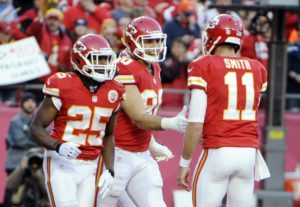KANSAS CITY, Mo. – The well-documented passing woes of 2013 cast the spotlight on a Chiefs wide receiver corps that failed to produce a 700-yard receiver.

Dec 1, 2013; Kansas City, MO, USA; Kansas City Chiefs tight end Anthony Fasano (80) celebrates with running back Jamaal Charles (25) and quarterback Alex Smith (11) after catching a touchdown pass against the Denver Broncos at Arrowhead Stadium. Credit: John Rieger-USA TODAY Sports
But flying under the radar is an area devastated by injuries, and a lack of attention to the position doesn’t diminish its importance to coach Andy Reid’s version of the West Coast offense.
The tight end is an essential component of Reid’s scheme, a point former Philadelphia Eagles quarterback Koy Detmer emphasized in a January 2013 article originally published at Pro Football Weekly.
“The relationship between a quarterback and tight end is very important because of the route concepts,” Detmer said then. “The tight end is a big part of it because if he’s not the primary receiver, he’s almost always the secondary receiver. That becomes a real big deal to a West Coast offense with the tight end.”
Unfortunately, Reid’s offense was dealt a blow when Travis Kelce, the first of the Chiefs’ two third-round picks (63rd overall), suffered a preseason knee injury. The Chiefs eventually placed Kelce on injured reserve in early October following his microfracture knee surgery.
Former Eagles tight end Chad Lewis, a three-time Pro Bowl selection and second-team All-Pro under Reid, highlighted in a phone interview the significance of losing Kelce.
“Whenever Andy (Reid) drafts someone, he’s looking for that player to have an impact on the team,” Lewis said. “When they get hurt, it’s a hole there. Even though they’re probably not going to be the starter right off the bat, they’re drafted and brought in to bring some juice to have an impact.”
Former Eagles scout John Middlekauff, who is currently a contributing on-air analyst for Comcast SportsNet-Bay Area, echoed Lewis’ thoughts.
“I think one thing that hurt them last year, obviously Travis Kelce, he was a guy that many people around the league thought was a talented a guy within the draft at tight end,” Middlekauff said in a phone interview. “So once he went down, they were really doing a lot of patchwork at that position. They were really limited offensively when it came to the tight end position. The tight end really helps feed the wide receivers.”
The patchwork approach Middlekauff mentions began with the claiming of Sean McGrath off waivers from the Seattle Seahawks on Sept. 1. McGrath appeared in 16 regular-season games with nine starts, leading all Chiefs tight ends with 26 catches for 302 yards to go along with two touchdowns.
Free-agent acquisition Anthony Fasano, who missed four games with an ankle injury and two with a concussion, finished the regular season with 23 catches for 200 yards and three touchdowns.
Nevertheless, the offense sputtered even with McGrath’s steady play during Fasano absence, perhaps a result of McGrath not being in training camp with the Chiefs and his inexperience in Reid’s offense.
Former Eagles tight end Luther Broughton, who played two seasons for Reid from 1999-2000, had a similar situation as McGrath. Broughton joined the Eagles after training camp following a trade with the Carolina Panthers on Sept. 5, 1999.
However, the difference between Broughton and McGrath is the former had experience in the system as a 1997 fifth-round draft pick (155th overall) of the Eagles and the Panthers ran a West Coast offense.
Now an underwriter with Quicken Loans, Broughton said in a phone interview his transition back to Philadelphia came easy, adding it takes at least a year for a tight end not familiar with the concepts to acclimate.
“You’re going to have your growing pains early on because it’s just different,” Broughton said. “The West Coast offense is terminology. You’re not having a route tree where you know to just run that route. Your play and what you’re doing is based off that terminology, and then you have reads within the play.”
Lewis, currently an associate athletic director at Brigham Young University, agreed with his former teammate and training camp roommate.
“If the offensive system in college was nothing like the West Coast offense, then it will be challenging to pick it up and it might even take as a tight end a year to get comfortable,” Lewis said. “But there are a lot of things about the offense that are very basic and if you’re a playmaker, you can have an immediate impact.”
Still, if mastering the offensive terminology appears confusing for a layman, imagine what a player new to the intricacies of the system must feel.
Broughton said what’s expected of a tight end in Reid’s version of the West Coast offense takes learning to another level.
“That playbook, I think that thing weighed more than 10 pounds,” Broughton said. “I remember telling my college teammates, ‘You’ve got to be kidding me. I’ve never studied this much in my life.’ I went to Furman – it’s not a shabby school – and I studied more than I studied for class. That offense is complex.”
Reid’s multifaceted system experienced a sluggish start to the 2013 season and the passing game proved inconsistent. Through the first eight weeks, the Chiefs passing game ranked 24th (208.8 yards per game) in the league.
While the passing attack had flashes of brilliance in the second half, the end of the regular season showed the Chiefs finished at 24th with the same 208.8 yards passing per game average they held at the midpoint of the season.

Aug 9, 2013; New Orleans, LA, USA; Chiefs tight end Travis Kelce (87) during a preseason game at the Mercedes-Benz Superdome. Credit: Derick E. Hingle-USA TODAY Sports
Fingers will likely continue pointing to the wide receiver production. But tight ends Fasano, McGrath, Kevin Brock, Richard Gordon and Dominique Jones combined for 53 catches for 541 yards and five touchdowns.
To put that production in perspective, the last time a Reid-coached offense didn’t do well at the tight end position came seven seasons ago in 2007 when the Eagles tight ends totaled 49 catches for 522 yards and three touchdowns.
Meanwhile, Lewis kept an eye on his former head coach’s progress with the Chiefs last season.
He said McGrath did a good job when Fasano was hurt and he complimented Fasano’s ability to make plays. But Lewis adds there should be competition this year based on what he knows of Reid.
“I think as the Chiefs continue to add dynamic players to their lineup, especially playmakers at each spot, and since we’re talking tight ends, the tight end position,” Lewis said. “It doesn’t mean the guys they have can’t make plays.
“Andy’s philosophy has always been bring in as much talent as possible, have as much competition in training camp as possible because that makes the team better. It brings out the best in you, so he will try and add the best talent possible to the guys that are already there. It will make them better; they’ll in turn help the young guys get better.”
Of course, having a healthy Kelce will enhance the offense, as would a healthy Fasano and all returning tight ends now with a year in Reid’s system under their belts.
[Related: Kelce hopes to help open up Chiefs offense]
The Chiefs are potentially in the market to add a wide receiver during May’s NFL Draft, but the key to the passing offense remains at a receiving position that shouldn’t be overlooked in Reid’s offense.
“With Travis Kelce coming back, that’s going to be a huge upgrade in the passing game,” Middlekauff said. “I was around Andy Reid with Brent Celek, the tight end is a huge part of his offense and last year they were decimated at that position. I would keep an eye on Travis Kelce even more than a rookie wide receiver to have a huge impact next year.”
And if the Chiefs get the production the system caters to, Broughton, whose four touchdowns in 1999 with the Eagles tied for the team lead, said the tight ends will have fun.
“That offense is made for a tight end to excel,” Broughton said. “A guy like me – I’m not putting myself down, I had enough talent to be good enough – but a backup tight end, a guy like me was able to thrive in that offense.”
